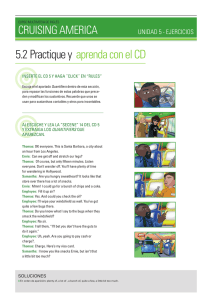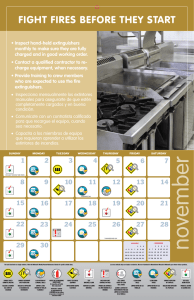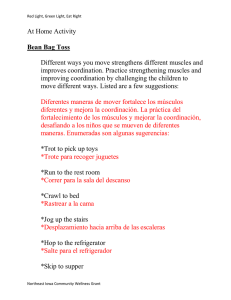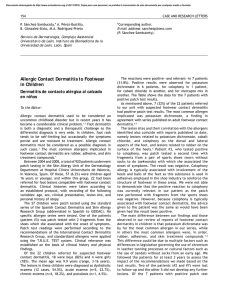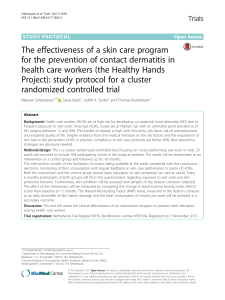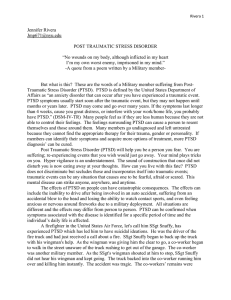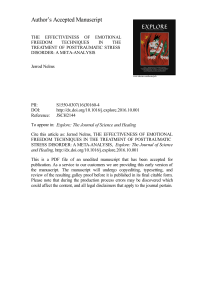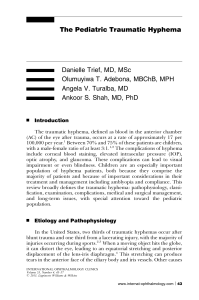Post–Traumatic Stress Disorder - California State Compensation
Anuncio
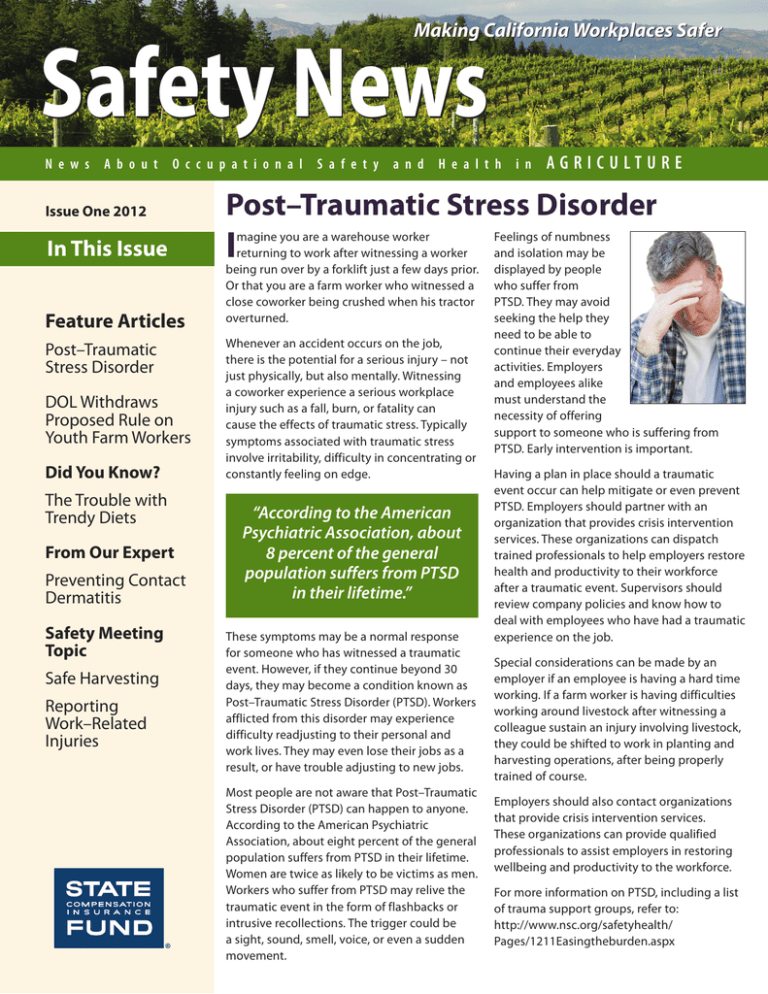
Making California Workplaces Safer Safety News N e w s A b o u t O c c u p a t i o n a l Issue One 2012 In This Issue Feature Articles Post–Traumatic Stress Disorder DOL Withdraws Proposed Rule on Youth Farm Workers Did You Know? The Trouble with Trendy Diets From Our Expert Preventing Contact Dermatitis Safety Meeting Topic Safe Harvesting Reporting Work–Related Injuries S a f e t y a n d H e a l t h i n AGRICULTURE Post–Traumatic Stress Disorder I magine you are a warehouse worker returning to work after witnessing a worker being run over by a forklift just a few days prior. Or that you are a farm worker who witnessed a close coworker being crushed when his tractor overturned. Whenever an accident occurs on the job, there is the potential for a serious injury – not just physically, but also mentally. Witnessing a coworker experience a serious workplace injury such as a fall, burn, or fatality can cause the effects of traumatic stress. Typically symptoms associated with traumatic stress involve irritability, difficulty in concentrating or constantly feeling on edge. “According to the American Psychiatric Association, about 8 percent of the general population suffers from PTSD in their lifetime.” These symptoms may be a normal response for someone who has witnessed a traumatic event. However, if they continue beyond 30 days, they may become a condition known as Post–Traumatic Stress Disorder (PTSD). Workers afflicted from this disorder may experience difficulty readjusting to their personal and work lives. They may even lose their jobs as a result, or have trouble adjusting to new jobs. Most people are not aware that Post–Traumatic Stress Disorder (PTSD) can happen to anyone. According to the American Psychiatric Association, about eight percent of the general population suffers from PTSD in their lifetime. Women are twice as likely to be victims as men. Workers who suffer from PTSD may relive the traumatic event in the form of flashbacks or intrusive recollections. The trigger could be a sight, sound, smell, voice, or even a sudden movement. Feelings of numbness and isolation may be displayed by people who suffer from PTSD. They may avoid seeking the help they need to be able to continue their everyday activities. Employers and employees alike must understand the necessity of offering support to someone who is suffering from PTSD. Early intervention is important. Having a plan in place should a traumatic event occur can help mitigate or even prevent PTSD. Employers should partner with an organization that provides crisis intervention services. These organizations can dispatch trained professionals to help employers restore health and productivity to their workforce after a traumatic event. Supervisors should review company policies and know how to deal with employees who have had a traumatic experience on the job. Special considerations can be made by an employer if an employee is having a hard time working. If a farm worker is having difficulties working around livestock after witnessing a colleague sustain an injury involving livestock, they could be shifted to work in planting and harvesting operations, after being properly trained of course. Employers should also contact organizations that provide crisis intervention services. These organizations can provide qualified professionals to assist employers in restoring wellbeing and productivity to the workforce. For more information on PTSD, including a list of trauma support groups, refer to: http://www.nsc.org/safetyhealth/ Pages/1211Easingtheburden.aspx Safety News State Compensation Insurance Fund Issue One 2012 DOL Withdraws Proposed Rule on Youth Farm Workers Washington – Following intense criticism from the agricultural community and antiregulation advocates, the Department of Labor withdrew a proposed rule that would have placed certain labor restrictions on children working on farms. The proposal would have revised child labor regulations to prohibit minors younger than 16 from operating most power-driven equipment or being involved in the storing, marketing and transporting of farm-product raw materials. When the proposal was issued last September, labor officials said the rule – which would not have applied to children working on their parents’ farms – was warranted given the high rate of young worker deaths in the agriculture industry. In an April 26 statement, Secretary of Labor Hilda L. Solis said her department was withdrawing the rule out of concerns for how it might affect small family-owned farms, which often employ youths who are not immediate family members. The American Farm Bureau Federation called DOL’s withdrawal the “right decision,” stating the rule would have prevented many young adults from working in the agriculture industry. Sen. Jerry Moran (R-KS), who late last year began calling for DOL to withdraw the rule, similarly applauded the department’s decision. “If this proposal had gone into effect, not only would the shrinking rural workforce have been further reduced and our nation’s youth deprived of valuable career training opportunities, but a way of life would have begun to disappear,” Moran said. Instead, Solis said, DOL and the Department of Agriculture will work with rural stakeholders to develop an education program aimed at promoting safe work practices among youths in agriculture. An average of 113 people younger than 20 die from farm-related injuries each year, according to the National Institute of Occupational Safety and Health (NIOSH). Youth workers 15-17 years old have more than 4 times the risk of dying on the job in the agricultural industry than the average 15- to 17-year-old worker, DOL said in the proposed rule, citing Bureau of Labor Statistics figures. Reprinted from Safety+Health magazine, Vol. 185, No. 6. ©2012 National Safety Council. Did You Know? The Trouble with Trendy Diets E very day it seems a new diet fad becomes the rage. These trendy diets often place an emphasis on certain food types and as a result limit your nutritional intake. Not to mention they have a tendency to fail over the long term. The key to maintaining a healthy lifestyle is balance—from the foods you eat, to the beverages you consume and your amount of daily physical activity. For health conscious eating, consider including a variety of nutritional foods that include: • Fruits and vegetables • Whole grains • Low fat or fat free milk products • Lean meats such as poultry and fish • Beans, eggs and nuts • Foods low in saturated fats, trans-fats, cholesterol, salt, and added sugars The amount of physical activity needed varies from person to person. Here are some general guidelines: To maintain weight: Work your way up to 150 minutes of moderate-intensity aerobic activity, 75 minutes of vigorous-intensity aerobic activity, or an equivalent mix of the two each week. To lose weight: A high amount of physical activity is necessary unless you adjust your diet and reduce the amount of calories you’re eating and drinking. The total number of calories burned varies depending on your age, gender, height, weight, and level of physical activity. For estimated calorie needs, refer to table 2–3 from the 2010 Dietary Guidelines for Americans. http://health.gov/dietaryguidelines/ dga2010/DietaryGuidelines2010.pdf Keeping fit involves healthy eating coupled with regular physical activity. For more information, refer to the Centers for Disease Control and Prevention (CDC): http://www.cdc.gov/healthyweight/index.html Safety News State Compensation Insurance Fund Issue One 2012 From Our Expert Preventing Contact Dermatitis C ontact dermatitis is an inflammation of the skin, and a common occupational disease that affects workers across a wide range of occupations and industries. Cases of contact dermatitis can vary from mild to severe and result in lost time or even disability. Symptoms may include: • Itching • Pain • Redness • Swelling • Blistering Identifying a problem is the first step towards prevention. Employers should conduct a job hazard analysis and review Material Safety Data Sheets (MSDS) to determine where skin contact with potentially irritating and sensitizing agents may occur. Once a hazard is identified, control measures need to be implemented. Eliminating contact with skin damaging agents is the most effective way to prevent contact dermatitis. Whenever possible, use less hazardous substances, make changes to a process or procedure to eliminate or minimize contact, and implement engineering controls, such as ventilation. • Dry,flakingandcrackingskin Irritant contact dermatitis (ICD) is the result of contact with substances irritating to the skin. Particularly irritating substances may have an immediate effect. Other substances may have an effect only after repeated or prolonged exposures. ICD can result from exposure to chemicals, weak cleaning agents, detergents, and even water. Allergic contact dermatitis (ACD) occurs when a sensitized individual has dermal contact with a skin allergen. A worker may not be allergic to the substance initially, but over time, repeated exposures can cause sensitization. Once sensitized, even a small exposure can cause a reaction. Contact dermatitis can result from immersing hands in chemicals, splashes to the skin, touching contaminated surfaces or rags, and skin contact with mists or dusts. Contact with certain plants, food substances, and woods can cause dermatitis. Personal Protective Equipment (PPE) may be necessary. PPE may include gloves and other protective clothing, safety glasses or goggles, and face shields. Be sure to select the proper PPE. Gloves, for example, must be resistant to the substance(s) of concern and not introduce a hazard themselves. Some chemicals used in glove manufacturing can cause ACD, and latex glove use can result in latex allergy. Gloves are available that reduce these risks. As part of an employer’s Hazard Communication Program, employees must be trained in the dermal hazards of the substances they work with and steps the employer has implemented to protect workers. Employees must also be trained in the proper use and care of PPE. Employees experiencing symptoms of occupational dermatitis should inform their employer and seek the advice of a medical professional. For a list of some occupations at risk and substances that can cause ICD and ACD, visit http://www.ccohs.ca/ oshanswers/diseases/. Beth Mohr, Ph.D., CIH is a Certified Industrial Hygienist at State Fund. Safety News State Compensation Insurance Fund Safety Meeting Topic Safe Harvesting H arvest time means more workers and equipment working under a more constrained schedule, so the potential for accidents and injuries increases. Employers and workers can optimize safety during this period by inspecting the worksite, training employees, and maintaining equipment before the harvest work begins. Conduct worksite inspections of maintenance sheds and fields. Hazards should be corrected or communicated to workers. Inspections also help to identify worker training and Personal Protective Equipment (PPE) needs that should be completed before harvest begins. Training before harvest prepares workers to safely operate and maintain the equipment they use. Workers should be instructed on the specific hazards associated with their harvest machinery. Caught and crush (entanglement) injuries should be emphasized so workers take precautions to avoid them. Workers must receive training on the use and maintenance of the necessary PPE for harvesting: • Work boots • Gloves • Coveralls • Hard hats • Eye protection • Hearing protection • Respiratory protection To prepare workers for field safety, they need training on first aid, sun protection, heat/cold stress, and the bugs and animals they may encounter. Ergonomic safety and procedures should be emphasized to eliminate strains and sprains. Workers should get as much sleep as possible and avoid alcohol and stimulants that could impair judgment and reaction times. “Training before harvest prepares workers to safely operate and maintain the equipment they use.” Harvesting equipment should NOT be used unless it is in proper working condition and should be lockedout/blockedout during maintenance or repair. Never clean, maintain, adjust, or clear jams on equipment that is operating or powered. Secure hair and clothing to avoid entanglement. Workers should stay clear of discharge spouts, fans, conveyors, and other moving equipment parts to avoid projectile injuries. Instruct workers not to walk or stand between harvesting machines because the operator often has a limited line of sight. Harvest work often occurs in the dark before dawn and after sunset. Additional lighting may be required to allow for the safe movement of workers and machinery. Preparing equipment prior to harvest ensures that it is in good shape for the heavy workload. It should be inspected for proper guarding, and all worn parts should be repaired or replaced. Keeping extra parts on hand during harvest allows quick equipment repairs so employees are less likely to “make do” with broken machinery. Issue One 2012 Topic Review Instructor ___________________________ Date _______________________________ Location ___________________________ Attended by 1. _____________________________________ 2. _____________________________________ 3. _____________________________________ 4. _____________________________________ 5. _____________________________________ 6. _____________________________________ 7. _____________________________________ 8. _____________________________________ 9. _____________________________________ 10. _____________________________________ 11. _____________________________________ 12. _____________________________________ Safety Recommendations _____________________________________ _____________________________________ _____________________________________ _____________________________________ _____________________________________ _____________________________________ _____________________________________ _____________________________________ _____________________________________ _____________________________________ _____________________________________ _____________________________________ _____________________________________ Reporting Work–Related Injuries State Fund’s Customer Service Center 888-STATEFUND (888-782-8338) is available 24 hours a day, 7 days a week for policyholders to report injuries as soon as they occur. Agents will do the necessary paperwork to get the claim started and refer the injured worker to the designated physician or provider. Within eight hours of any serious illness or injury (requiring hospitalization over 24 hours, other than for medical observation or where there is permanent employee disfiguration) or death occurring in the workplace or in connection with employment, employers must report the incident to the Division of Occupational Safety and Health. Safety News State Compensation Insurance Fund Temas de Seguridad Cosecha Segura L a temporada de cosecha significa más trabajadores y equipos trabajando con un horario más restringido, así que la probabilidad de accidentes y lesiones también aumenta. Los empleadores y los trabajadores pueden optimizar la seguridad durante este período mediante la inspección del sitio de trabajo, la capacitación de los empleados y el mantenimiento del equipo antes de que comience el trabajo de la cosecha. capacitación sobre primeros auxilios, protección solar, prevención del estrés debido al frío/calor y precauciones contra los insectos y animales que ellos puedan encontrar. Debe destacarse la seguridad y los procedimientos ergonómicos a fin de eliminar los esguinces y las torceduras. Los trabajadores deben dormir tanto como sea posible y evitar el alcohol y los estimulantes que puedan afectarles el buen juicio y los tiempos de reacción. Lleve a cabo inspecciones del sitio de trabajo en los cobertizos de mantenimiento y en los campos. Se debe corregir o comunicar a los trabajadores cualquier condición de riesgo. Además, las inspecciones ayudan a identificar las necesidades de capacitación de los trabajadores y de Equipo de Protección Personal (PPE) que se deben satisfacer antes del inicio de la cosecha. NO se debe utilizar equipos de recolección de cosechas a menos que estén en buenas condiciones de funcionamiento y se recomienda cerrar con candado y bloquear dichos equipos durante el mantenimiento o reparación. Nunca limpie, dé mantenimiento, ajuste ni despeje atascamientos en equipos que estén funcionando o energizados. Sujétese el cabello y la ropa para evitar que se enrede. Los trabajadores deben permanecer alejados de tubos de descarga, ventiladores, cintas transportadoras y otras piezas de equipo en movimiento para evitar lesiones por proyectiles. Instruya a los trabajadores a no caminar ni permanecer de pie entre las máquinas recolectoras de cosechas ya que el operador a menudo tiene una línea de visibilidad limitada. El trabajo de recolección de cosechas ocurre a menudo antes de la salida del sol y después de la puesta del sol. Quizá sea necesaria la iluminación adicional para permitir el movimiento seguro de los trabajadores y la maquinaria. La capacitación previa a la cosecha prepara a los trabajadores para operar y dar mantenimiento de manera segura a los equipos que ellos utilizarán. Los trabajadores deben recibir instrucción sobre los riesgos específicos relacionados con su maquinaria para recolección de cosechas. Se debe destacar el riesgo de lesiones por atoramiento y aplastamiento (que atrapado) para que los trabajadores tomen precauciones y las eviten. Los trabajadores deben recibir capacitación sobre el uso y mantenimiento del equipo PPE para la cosecha: • Botas de trabajo • Guantes • Overoles • Cascos de seguridad • Protección ocular • Protección auditiva • Protección respiratoria Para preparar a los trabajadores para la seguridad en el campo ellos necesitan La preparación de los equipos antes de la cosecha asegura que estos estén en buen estado de funcionamiento para el gran volumen de trabajo. Se recomienda inspeccionarlos para verificar que tengan las protecciones adecuadas y se debe reparar o reemplazar todas las partes gastadas. Mantener a la mano repuestos adicionales durante la cosecha permite realizar reparaciones rápidas de los equipos para que los empleados tengan menos probabilidades de “ingeniárselas” con maquinaria descompuesta. Issue One 2012 Revisión Del Tema Instructor ___________________________ Fecha ______________________________ Ubicación ___________________________ Asistente(s) 1. _____________________________________ 2. _____________________________________ 3. _____________________________________ 4. _____________________________________ 5. _____________________________________ 6. _____________________________________ 7. _____________________________________ 8. _____________________________________ 9. _____________________________________ 10. _____________________________________ 11. _____________________________________ 12. _____________________________________ Recomendaciones de seguridad _____________________________________ _____________________________________ _____________________________________ _____________________________________ _____________________________________ _____________________________________ _____________________________________ _____________________________________ _____________________________________ _____________________________________ _____________________________________ _____________________________________ _____________________________________ _____________________________________ This Agriculture Safety News is produced by the Corporate Communications Department of State Fund to assist clients in their loss control efforts. Information or recommendations contained in this publication were obtained from sources believed to be reliable at the date of publication. Information is only advisory and does not presume to be exhaustive or inclusive of all workplace hazards or situations. Permission to reprint articles subject to approval by State Compensation Insurance Fund. Published by State Compensation Insurance Fund’s Corporate Communications Department. © State Compensation Insurance Fund 2012
